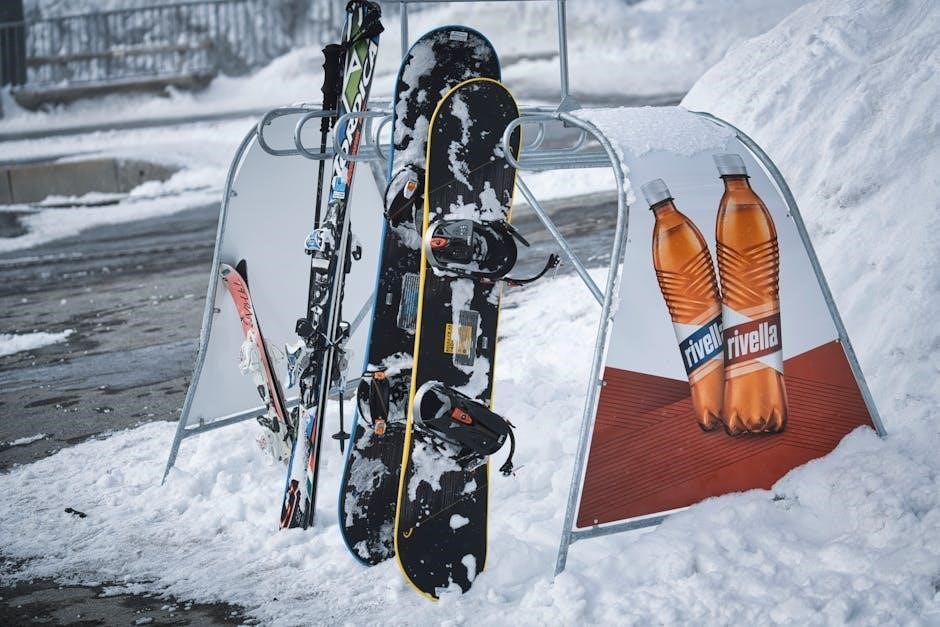Understanding Ski Bindings
Ski bindings are crucial for connecting your boots to skis, ensuring control and safety. They consist of a toe piece and heel piece, designed to secure your boots firmly. Compatibility with boot size and ski width is essential. Brake width must match the ski’s waist width, with a maximum overhang of 15mm. Proper sizing ensures optimal performance and safety, preventing premature release or failure to release when needed. Always consult a size chart or professional to determine the ideal fit for your setup.

Measuring Ski Waist Width
Measuring the waist width of your skis is a critical step in selecting the right bindings. The waist width refers to the narrowest part of the ski, typically measured under the boot. This measurement is essential because it determines the appropriate brake width of the binding. Most modern skis have their dimensions printed on the manufacturer’s label, usually in the format of three numbers (e.g., 115/90/112), where the middle number represents the waist width.
To measure the waist width manually, place the ski on a flat surface and locate the area directly under the boot. Use a ruler or soft tape measure to find the width at this point. Ensure the measurement is taken perpendicular to the length of the ski. If the ski is older or the markings are unclear, this manual method is the most reliable. For accurate results, avoid compressing the ski or applying pressure, as this can distort the measurement.
The waist width measurement is crucial because it determines the maximum brake width of the binding. Most bindings are designed to accommodate a specific range of waist widths, and exceeding this range can lead to poor performance or safety issues. For example, if your skis have a waist width of 92mm, the ideal binding brake width should be equal to or no more than 15mm wider than this measurement. This ensures proper fit and functionality.
In addition to the waist width, consider the overall shape of the ski. Skis with a wider waist width (e.g., 100mm or more) are typically used for powder or backcountry skiing, while narrower skis (e.g., 80mm or less) are better suited for groomed trails or racing. Matching the binding size to the ski waist width ensures optimal performance and safety.
For precise measurements, use a digital caliper or consult a professional at a ski shop. They can provide accurate readings and recommend compatible bindings based on your ski dimensions. Always double-check your measurements to avoid errors, as incorrect binding size can lead to compatibility issues or compromised safety on the slopes.

Determining Boot Compatibility
Determining boot compatibility is a vital step in selecting the right ski bindings. Boot compatibility ensures that the binding can properly secure your boot, providing both safety and performance. The primary factor to consider is the boot’s sole length, which must fall within the binding’s adjustable range. Most bindings are designed to accommodate a specific range of boot sizes, so it’s essential to check the manufacturer’s specifications.
The boot’s sole length is measured in millimeters and is typically found on the boot’s packaging or printed on the sole itself. For example, a boot with a sole length of 315mm will require a binding that can accommodate this size. Additionally, the type of boot you have (alpine, touring, or all-mountain) will influence compatibility. Alpine boots, for instance, are designed to work with standard alpine bindings, while touring boots may require bindings with a different mechanism.
Another critical factor is the boot’s ISO standard. Modern ski boots are designed to meet specific ISO standards, such as ISO 5355 for alpine boots or ISO 9523 for touring boots. Ensure that your binding is compatible with your boot’s ISO standard to guarantee proper functionality. Some bindings are compatible with multiple ISO standards, offering greater versatility for skiers who use different types of boots.
The flex of the boot and binding should also be considered. A stiffer boot requires a binding with a higher DIN setting to ensure proper release and control. Conversely, a softer boot may require a binding with a lower DIN range. Matching the boot’s flex to the binding’s performance capabilities ensures optimal skiing efficiency and safety.
Finally, consider the adjustable features of the binding. Many modern bindings offer adjustable toe and heel pieces, allowing for fine-tuning to fit your boot perfectly. However, most bindings have limited adjustment ranges, so it’s crucial to select a binding that closely matches your boot’s sole length and type. Always consult the manufacturer’s compatibility chart or seek advice from a professional ski technician to ensure a proper fit.

Calculating DIN Settings
Calculating DIN settings is a critical step in ensuring your ski bindings function safely and effectively. DIN (Deutsche Industrie Norm) settings determine the release force of the binding, which must be tailored to your specific needs to prevent injuries. The DIN setting is calculated based on your weight, height, age, boot sole length, and skier type. These factors are used in conjunction with a DIN chart or calculator to determine the appropriate release value.
Your weight is the most significant factor in determining the DIN setting, as it directly impacts the force required to release the binding. Height and age are also considered, as they provide additional context for your overall physical profile. Boot sole length is measured in millimeters and is typically found on the boot’s packaging or printed on the sole itself. This measurement helps ensure the binding is properly sized for your boot.
Skier type is categorized into three levels: Type 1 (cautious, light skiers), Type 2 (average skiers), and Type 3 (aggressive, heavy skiers). Your skier type influences the release sensitivity, with more aggressive skiers requiring higher DIN settings to prevent premature release during high-speed or high-impact skiing. The DIN setting must fall within the binding’s advertised range, so it’s essential to choose bindings that can accommodate your calculated DIN value.
Professional ski technicians often use a DIN calculator or table to determine the precise setting. However, smartphone apps and online tools are also available for self-calculation. Always double-check your calculations and consult a professional if you’re unsure. Improperly set DIN settings can lead to either too early or too late a release, both of which can result in injuries or equipment damage. By carefully calculating your DIN settings, you ensure a safer and more enjoyable skiing experience.
Remember, your DIN setting may need to be adjusted over time due to changes in your weight, skiing ability, or equipment. Regularly review and update your settings to maintain optimal performance and safety on the slopes.

Choosing Binding Type
Selecting the right type of ski binding is essential for ensuring compatibility with your skiing style, boot type, and ski setup. There are several types of bindings available, each designed for specific skiing disciplines and preferences. Understanding the differences will help you make an informed decision that enhances your performance and safety on the slopes.
Alpine Bindings
Alpine bindings are the most common type and are designed for downhill skiing at resorts. They are known for their durability, ease of use, and compatibility with standard alpine boots. These bindings are ideal for skiers who prioritize downhill performance and are less concerned with ascending or backcountry skiing. They typically feature a fixed heel piece and are available in a wide range of DIN settings to accommodate different skier profiles.
Touring Bindings
Touring bindings are designed for backcountry skiing, where skiers need to ascend as well as descend. These bindings feature a hinge at the toe, allowing the heel to lift for efficient climbing. They are lighter than alpine bindings and are compatible with boots that have a rockered sole. Touring bindings are perfect for skiers who spend time in the backcountry but still want solid downhill performance.
Demo/Rental Bindings
Demo or rental bindings are designed for versatility and adjustability. They feature sliding toe and heel pieces that can accommodate a wide range of boot sizes, making them ideal for rental shops or skiers who share skis. While they are convenient, they may lack some of the high-performance features found in other binding types.
Tech Bindings
Tech bindings, also known as pin bindings, are lightweight and minimalist, designed specifically for backcountry skiing. They use pins to secure the boot’s toe and a heel piece that must be manually locked for descending. Tech bindings are the lightest option but require compatible boots with tech inserts and are best suited for experienced backcountry skiers.
Choosing the right binding type depends on your skiing style, the terrain you frequent, and your personal preferences. Consider factors such as weight, adjustability, compatibility with your boots, and the level of performance you need. By selecting the appropriate binding type, you can ensure a safer, more enjoyable, and more efficient skiing experience.

Mounting the Bindings
Mounting ski bindings is a critical step that requires precision and care to ensure proper function and safety. Improperly mounted bindings can lead to performance issues, safety hazards, and potential damage to your skis. Whether you’re doing it yourself or relying on a professional, understanding the process is essential for achieving the best results.
Preparation
Before mounting, ensure your skis are clean and dry. Remove any old bindings, adhesive, or debris that might interfere with the new installation. Verify that the bindings are compatible with your skis and boots, and that all components are included and undamaged.
Positioning the Bindings
The mounting position is determined by your boot sole length and skiing style. Most bindings are mounted using a “boot center” reference point, which places the boot’s midpoint under the ski’s sweet spot for optimal balance and control. Adjustments can be made forward or backward based on personal preference or skiing technique.
Drilling and Screwing
Once the position is marked, drill pilot holes into the ski to avoid splitting the material. Use the binding’s screws to secure the toe and heel pieces firmly. Ensure the bindings are tightened evenly and in the correct sequence to maintain ski integrity. Over-tightening can damage the ski’s structure, while under-tightening may lead to loose bindings.
Final Adjustments
After mounting, test the bindings by stepping in and out to ensure smooth operation. Check the forward pressure, toe height, and heel retention for proper alignment and function. Any misalignment or uneven pressure can affect performance and safety.
For optimal results, consider consulting a professional ski technician, especially if you’re unsure about any step of the process. Properly mounted bindings will enhance your skiing experience, providing reliability and confidence on the slopes.

Adjusting the Bindings
Adjusting your ski bindings is a critical step to ensure proper performance, safety, and compatibility with your boots and skiing style. Properly adjusted bindings will provide the right balance of retention and release, allowing you to ski confidently and effectively. This process requires attention to detail and a basic understanding of how bindings function.
Toe Height Adjustment
The toe height adjustment ensures the binding’s toe piece aligns correctly with your boot’s toe. Improper alignment can cause inconsistent release or difficulty stepping in. To adjust, slide the binding’s toe piece along its track and tighten it once it matches the boot’s width. Always refer to the manufacturer’s instructions for specific adjustment procedures.
Forward Pressure Adjustment
Forward pressure ensures the binding holds your boot securely without over-tightening. Adjust the heel piece by turning the screw until it clicks when you press your boot into the binding. This setting ensures the binding releases properly during a fall while maintaining a snug fit during skiing.
Boot Sole Length Adjustment
Modern bindings often feature adjustable rails that allow you to slide the binding forward or backward to accommodate different boot sole lengths. Measure your boot sole length and position the binding accordingly. This ensures the boot sits correctly in the binding, preventing misalignment or poor performance.
DIN Setting Adjustment
The DIN setting determines the release force of the binding based on your weight, height, boot sole length, and skier ability. Use a DIN calculator or consult a professional to determine your correct setting. Adjust the screw on the heel piece to match your calculated DIN value, ensuring it falls within the binding’s range.
Testing the Adjustments
After making adjustments, test the bindings by stepping in and out to ensure smooth operation. Check for proper retention and release by flexing the ski or simulating a fall. Fine-tune any settings as needed to achieve the perfect balance of performance and safety.
By carefully following these adjustment steps, you can optimize your ski bindings for your specific needs, ensuring a safe and enjoyable skiing experience.

Testing the Bindings
Testing your ski bindings is a critical step to ensure they function correctly and safely. Properly tested bindings will perform reliably, offering both security and the ability to release when necessary. This process involves several key steps to verify functionality, compatibility, and safety.
Safety Checks
Begin by visually inspecting the bindings for any damage or wear. Check the toe and heel pieces, springs, and brakes for proper alignment and movement. Ensure all screws and components are securely tightened; If any part appears damaged or loose, do not proceed with testing—address the issue first.
Functionality Test
Step into the bindings with your boots to ensure they engage smoothly. Listen for a clear “click” as the boot locks into place. Flex the ski gently to test the binding’s forward pressure and retention. The boot should feel secure but not overly restrictive. Step out of the bindings to confirm they release cleanly without resistance.
Release Testing
Test the binding’s release mechanism by applying sideways and forward pressure to simulate a fall. The binding should release smoothly at the correct DIN setting, allowing the boot to disengage without sticking. Repeat this process several times to ensure consistent performance.
Compatibility Verification
Verify that the bindings are compatible with your boots and skis. Ensure the brake width matches the ski waist width and that the boot sole length aligns with the binding’s adjustment range. Misalignment can lead to poor performance or safety issues.
Professional Inspection
Even if you’ve conducted thorough testing, it’s recommended to have a professional ski technician inspect the bindings. They can verify that the DIN settings, forward pressure, and alignment are correct and ensure the bindings meet safety standards.
By systematically testing your ski bindings, you can ensure they are safe, functional, and ready for the slopes. Regular testing is essential to maintain performance and reliability throughout the season.

Maintenance Tips
Proper maintenance of your ski bindings is essential to ensure their longevity, performance, and safety. Neglecting routine care can lead to malfunction, which may compromise your skiing experience or even pose a risk of injury. Regular upkeep involves cleaning, lubrication, and inspection to keep the bindings in optimal condition.
Cleaning the Bindings
Dirt, snow, and ice can accumulate on the bindings, hindering their functionality. Use a soft brush or cloth to remove debris from the toe and heel pieces, springs, and brakes. Avoid using harsh chemicals or abrasive materials that could damage the components. For stubborn grime, a mild soap solution can be applied, but ensure the bindings are thoroughly rinsed and dried afterward.
Lubricating Moving Parts
Lubrication is crucial for maintaining the smooth operation of the bindings. Apply a small amount of silicone-based lubricant to the moving parts, such as the hinge points and springs. Over-lubrication should be avoided, as it can attract dirt and grime, leading to further issues.
Inspecting for Wear and Tear
Regularly inspect the bindings for signs of wear, such as cracks, rust, or excessive play in the components. Check the brake pads for wear, as they can become thin over time and fail to hold the skis securely. If any damage is detected, replace the affected parts immediately.
Storing the Bindings
When not in use, store your skis with bindings in a dry, cool place, away from direct sunlight. Avoid leaving the bindings engaged, as this can cause unnecessary stress on the springs. If storing for an extended period, apply a light layer of lubricant to protect against rust.
Tightening Screws
Over time, the screws that hold the bindings to the skis may loosen due to vibration and use. Periodically check and tighten these screws to ensure the bindings remain securely attached to the skis.
Professional Servicing
While routine maintenance can be done at home, it’s recommended to have your bindings professionally serviced at least once a season. A certified technician can perform a thorough inspection, adjust the bindings, and ensure they meet safety standards.
By following these maintenance tips, you can extend the life of your ski bindings, ensure reliable performance, and enjoy a safer skiing experience. Regular care is a small investment that pays off in the long run.

Selecting the Right Size
Selecting the right size for your ski bindings is a critical step to ensure compatibility with your skis, boots, and skiing style.Bindings come in various sizes, and choosing the wrong size can lead to poor performance, safety issues, or even damage to your equipment; Below are key considerations to help you determine the correct size for your ski bindings.
Brake Width
The most important factor in sizing ski bindings is the brake width, which must match the waist width of your skis. The waist width is the narrowest part of the ski, typically measured in millimeters (e.g., 90mm, 100mm). The brake width should be equal to or slightly wider than the ski waist width, with a maximum overhang of 15mm. Using a brake width that is too narrow can cause the brakes to drag on the snow, while a width that is too wide may not fit your skis properly.
Boot Sole Length
Your boot sole length also plays a role in determining the correct binding size. Most bindings are adjustable within a specific range, so ensure your boot sole length falls within the binding’s adjustment range. Consult the manufacturer’s size chart to confirm compatibility.
DIN Settings
The DIN setting on your bindings is determined by your weight, height, boot sole length, and skier type (beginner, intermediate, advanced). Ensure the binding’s DIN range matches your calculated DIN setting. For example, if your DIN setting is 8, choose bindings with a range that includes 8 (e.g., 4-12).
Compatibility
Check that your bindings are compatible with your skiing style and the type of skis you own. For instance, alpine bindings are designed for downhill skiing, while touring bindings are better suited for backcountry use. Additionally, ensure your bindings are compatible with your boot type (e.g., ISO 5355, GRIPWALK, or WTR).
Consulting a Size Chart
Refer to the manufacturer’s size chart to find the ideal binding size for your specific needs. These charts typically provide a range of ski waist widths and boot sole lengths that correspond to each binding size. If you’re unsure, consult a professional at a ski shop for assistance.
By carefully considering brake width, boot compatibility, DIN settings, and skiing style, you can select the right size for your ski bindings. Proper sizing ensures optimal performance, safety, and enjoyment on the slopes.

Leave a Reply
You must be logged in to post a comment.